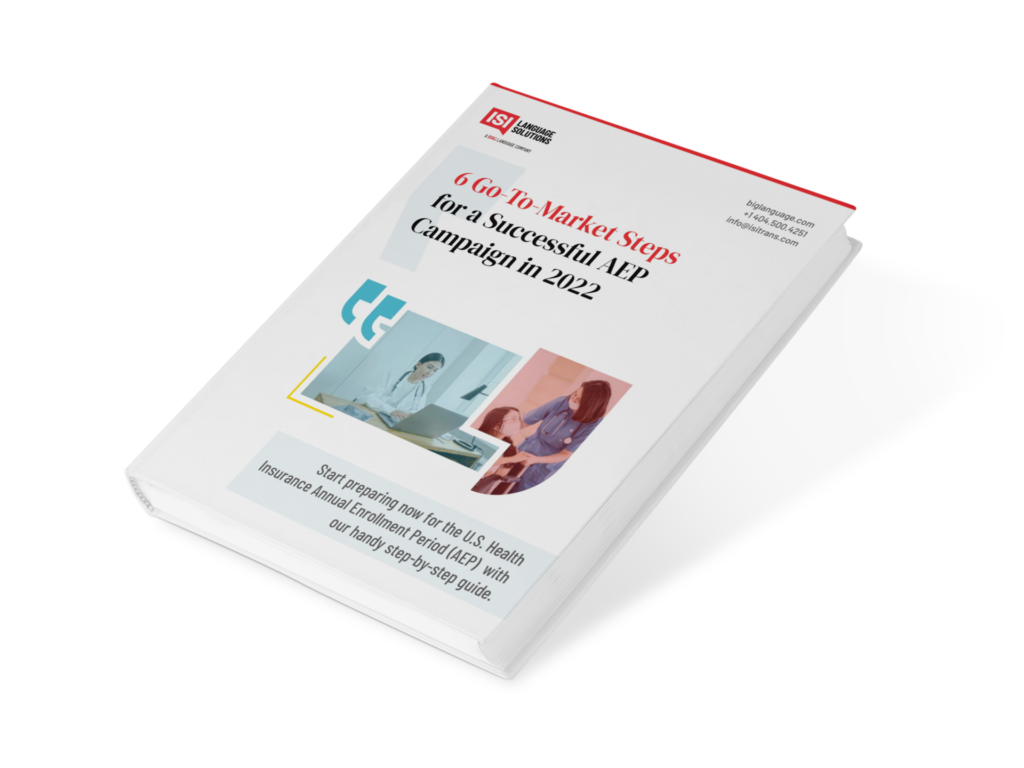With the U.S. Health Insurance Annual Enrollment Period (AEP) is due to start again in less than six months, now is the time to start thinking about translating this year’s enrollment kits. We asked Michael Bearden, Executive VP of Customer Success at BIG Language Solutions for some practical guidance on how to get started, including recommended timeframes, best practices for translation, and top tips for success.
Why Are We Talking About Open Enrollment Already?
It might seem too early to start thinking about your language program for the upcoming Open Enrollment period, but this is a major event on the annual healthcare calendar and takes considerable planning and preparation to execute smoothly. By starting now, healthcare insurers and plan providers can avoid unnecessary time pressures, stresses, and expenses in the future and ensure they produce their English and translated materials for their brokers at the same time and—ideally—ahead of the competition.
Why Are Translations So Important?
Providing materials in the language of your target markets is vital to success in servicing and targeting America’s sizable LEP communities. Understanding the diverse healthcare plan options and selecting the right plan is already a cause of headache for those U.S. citizens who are native English speakers but is even more challenging for those with limited-English proficiency (LEP) or who are newly arrived in the country. Imagine being a Hmong, Thai, or Japanese speaker and trying to understand copays, donut holes, deductibles, and all the different healthcare rules and regulations for the first time.
But, with healthcare organizations speaking more languages than ever before, planning and preparing translations for each potential market is no easy task. It is harder still when you consider the steps that healthcare insurers, especially those that receive Federal funding, need to take to comply with U.S. legislation, regulations, and recommended practices, not to mention the challenges of adhering to tight Centers for Medicare & Medicaid Services (CMS) deadlines.
What Should Insurers and Health Plan Providers Be Doing Now?
Many of our larger health insurance clients are already in the early planning stages, making decisions about resource allotment, planning capacity, and human capital, for example. Of course, there are still many unknowns; they may be waiting for senior leadership to make the final decisions on languages or required materials, the number of plans, kits, and so on. But, while they do not yet know the full extent of the project, they do know the work involved and the project management expertise that will be necessary to achieve it efficiently, accurately, and cost-effectively.
For those that have not started yet, an audit of last year’s activity is a good place to begin. This quieter period is the ideal time to take a step back to review what worked and what did not last time around and to start considering the materials, resources, and support needed to work on the project this year.
→Download our helpful guide to discover our six go-to-market steps for a successful AEP campaign, including suggested timelines for auditing materials, developing assets, planning for member communications post-enrollment, and defining the translation process and objectives with your chosen LSP.

Why Not Wait to Receive the Model Documents?
We have all been through the process enough times now to know that the deadline for CMS to issue its final model documents is a little “softer” than the hard deadline for Open Enrollment. Rather than squeeze preparation and translation time waiting for those final templates, it makes more sense to look at what you can do now.
One easy way to do this is to get a head start by gathering and preparing the materials and assets from last years, such as sales kits, enrollment forms, information guides, summaries of benefits, evidence of coverage (EOC), annual notices of change (ANOC), and so on, as well as your translation memory (TM), glossary, and other helpful tools. The more content you can prepare the better, even if it is simply a question of reviewing materials to assess which need a logo change and tagline only versus a complete overhaul with a new translation.
In addition, consider what has changed (or may change) in your roll-out for this year; for example, are you adding a new language or extending the length or scope of translations for specific documents? If you can prepare 90% of the documents that you already know you will need to translate, it will be a lot easier when you receive the final versions.
At its core, translation for Open Enrollment is as much a planning capacity and project management challenge as it is a translation one. Technology, processes, and version control are all key to success when it comes to ensuring the necessary adjustments are made to all materials including translations as things change, which of course they do.
Why Not Start With English First and Replicate?
Indeed, this used to be the accepted way to manage Open Enrollment translation. You would first finalize the English text, check and approve it internally, including validation by Legal, and then start to translate. But that meant healthcare brokers were sitting around waiting for the tools they needed to get started in LEP communities. Fortunately, we now have the project management processes, tools, and expertise to deliver translated materials concurrently, especially for core demographics such as Spanish and traditional Chinese.
Does That Not Cost More If the Materials are Constantly Changing?
This is often the assumption—and fear—for healthcare insurers, but starting earlier can actually save money in the long run with responsible budget management/cost control. After all, many of the documents we are talking about are simply different versions of the same document. You are not retranslating the entirety of a 400-page EOC each time, for example, but rather managing a single document with some variations.
By deploying the right tools and processes—in other words, deploying technology and personnel to leverage business intelligence—it is relatively simple to compare changes and manage versions. Plus, you will save on the rush fees, stress, and errors that inevitably occur when translations are left to the last minute.

What Can Go Wrong If You Wait Too Long to Start?
If you do not start early enough or you are not organized, then you are going to rush and could make mistakes. That can lead to fines and other financial penalties, or you may need to reprint some of your materials. Even worse, you might accidentally say something is deductible at a certain percentage or the wrong amount. If you multiply that error by millions of members, this could potentially mean massive exposure for your business.
Many healthcare insurers are nervous about switching language service providers (LSPs) for this reason. It can feel like a risk to make a change, even if it means putting up with errors, stress, and missed deadlines every new cycle. But there are only so many years that you can put up with delays, rush fees, overpayments, or document mix-ups. And, if you are consistently slower to market than your competitors, you will also be losing out financially, irrespective of the quality of your existing vendor’s work.
How Can You Be Sure to Choose the Right Partner?
Proven efficiency and accuracy are crucial. Many LSPs may be able to translate healthcare materials, but very few will have the processes and experiences needed to track Open Enrollment projects and deadlines effectively. That is why it is so critical to work with an AEP specialist who understands the calendar dates, document types, and necessary workflows and allocates resources accordingly. As importantly, they need to hold the business intelligence that you only gain from going through this process time and time again.
BIG Language Solutions has been managing Open Enrollment for some of the biggest healthcare insurers in the U.S, since 1982, so we know how to manage this process inside out. In fact, our larger clients measure our work according to key deliverables, such as our ability to launch multilingual materials at the same time the English kits are finalized, as well as budget and time management.
We liken our Open Enrollment teams to an elite task force. The first team focuses specifically on translations for enrollment kits, while the second works on the welcome kits. We organize personnel this way because we know the challenges and timeframes inside out and want to ensure that our teams are available at crunch times. That means no holidays at critical times, such as mid-July to early September, and rotated shifts and weekend schedules so our clients can be sure of all-hands-on-deck and around-the-clock support when they need it most.
What Would Be Your Main Piece of Advice to Healthcare Insurers?
If you want to get to market quicker, you need to start planning earlier. That means creating a clear plan for everything from key personnel to the format of deliverables and setting up lines of communication between you and your LSP.
What you do not want to do is simply throw content “over the fence” for translation. The more and quicker your LSP can know about your project scope, the smoother the project will run, so aim for complete transparency, including connecting them directly to your internal document owners. For some clients, we have project managers in their offices under professional service agreements to ensure they are up-to-speed on timeframes and deliverables and empowered to keep translation front of mind from the beginning of the Open Enrollment creation process.
BIG Language Solutions specializes in helping leading insurers and health plans increase member enrollment and reduce expenses in non-English and limited-English proficient target markets by offering customized language access services. Find out more about our dedicated health insurance translation and interpreting services, or contact us today for tailor-made advice or support.







